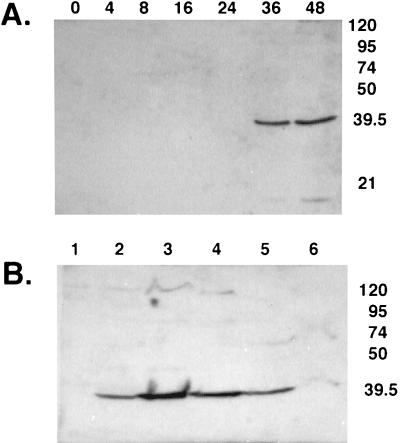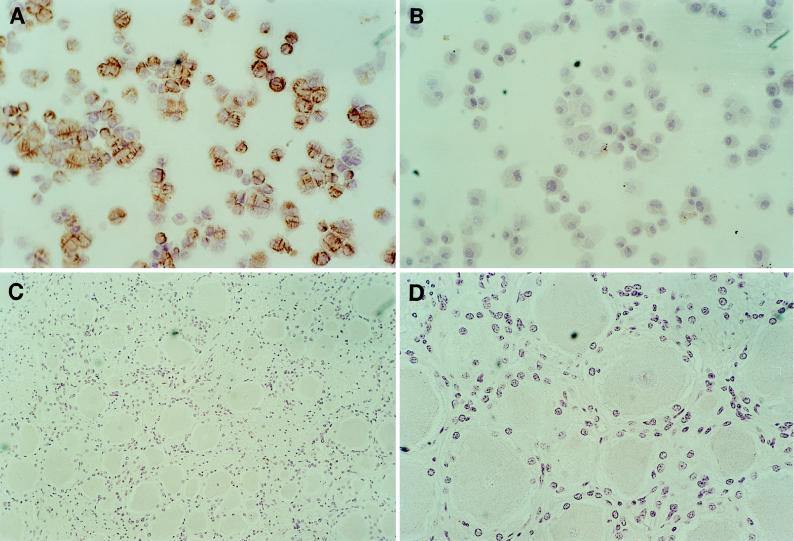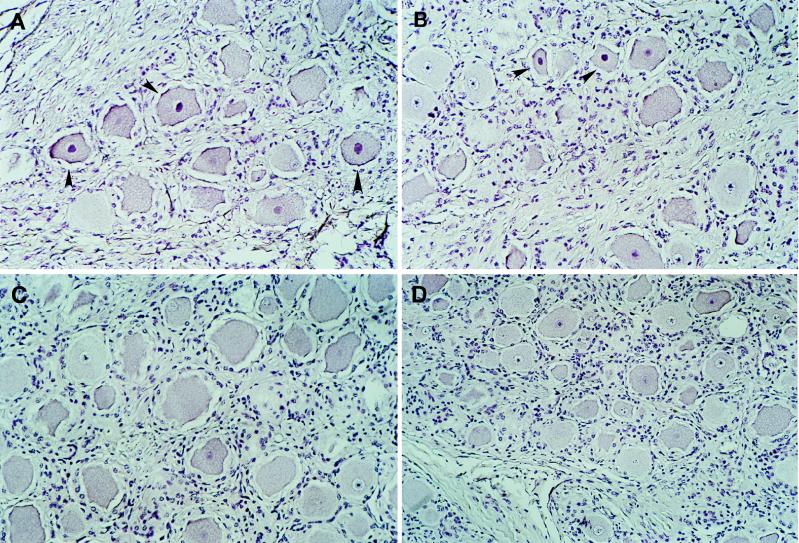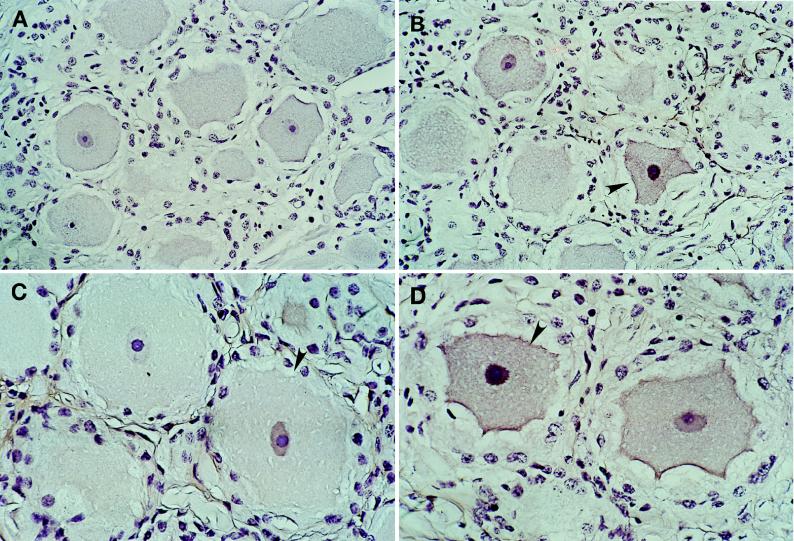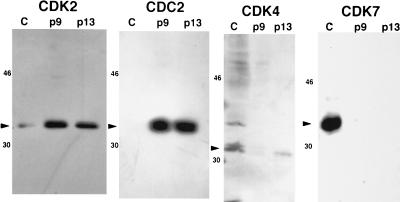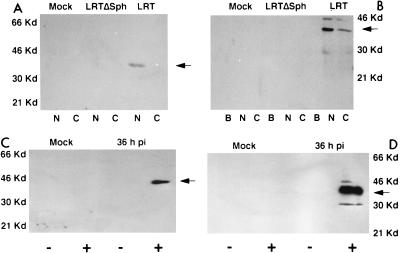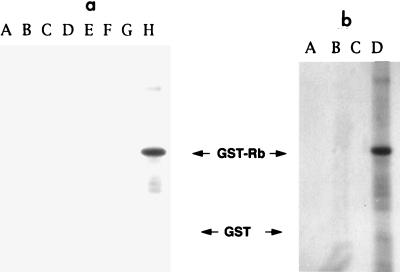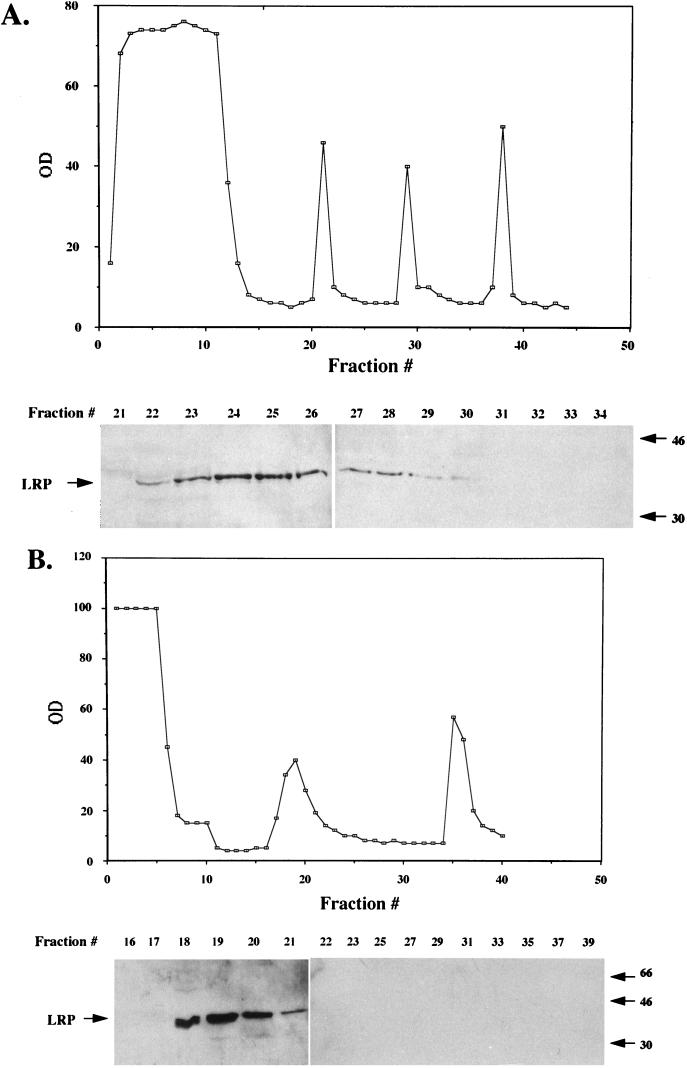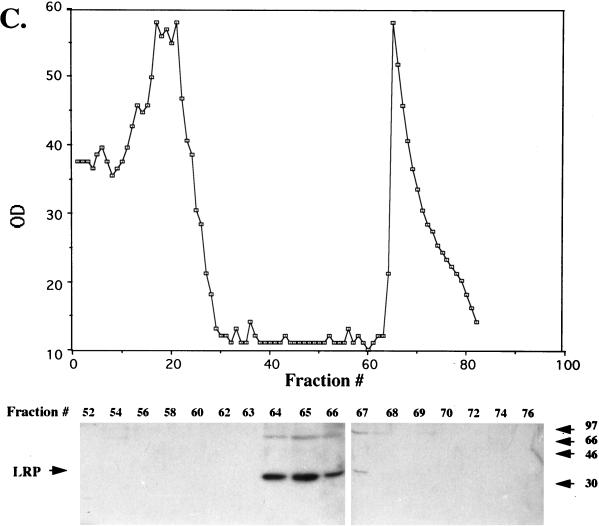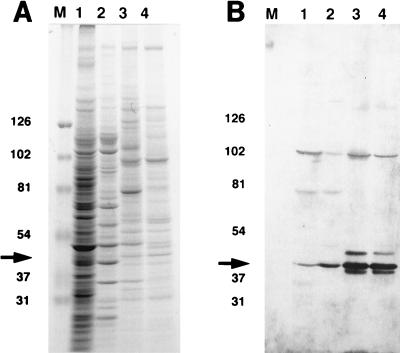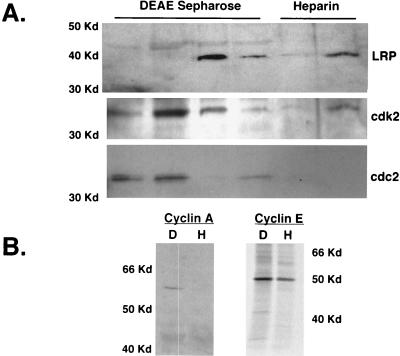Abstract
Despite productive viral gene expression in the peripheral nervous system during acute infection, the bovine herpesvirus 1 (BHV-1) infection cycle is blocked in sensory ganglionic neurons and consequently latency is established. The only abundant viral transcript expressed during latency is the latency-related (LR) RNA. LR gene products inhibit S-phase entry, and binding of the LR protein (LRP) to cyclin A was hypothesized to block cell cycle progression. This study demonstrates LRP is a nuclear protein which is expressed in neurons of latently infected cattle. Affinity chromatography indicated that LRP interacts with cyclin-dependent kinase 2 (cdk2)-cyclin complexes or cdc2-cyclin complexes in transfected human cells or infected bovine cells. After partial purification using three different columns (DEAE-Sepharose, Econo S, and heparin-agarose), LRP was primarily associated with cdk2-cyclin E complexes, an enzyme which is necessary for G1-to-S-phase cell cycle progression. During acute infection of trigeminal ganglia or following dexamethasone-induced reactivation, BHV-1 induces expression of cyclin A in neurons (L. M. Schang, A. Hossain, and C. Jones, J. Virol. 70:3807–3814, 1996). Expression of S-phase regulatory proteins (cyclin A, for example) leads to neuronal apoptosis. Consequently, we hypothesize that interactions between LRP and cell cycle regulatory proteins promote survival of postmitotic neurons during acute infection and/or reactivation.
Bovine herpesvirus 1 (BHV-1) is a significant viral pathogen of cattle which causes respiratory disease, abortions, genital disease, or occasionally encephalitis (32). Like other members of the Alphaherpesvirinae family, BHV-1 establishes a latent infection in sensory ganglionic neurons (reviewed in references 22 and 23). Viral DNA persists in these neurons for the lifetime of infected cattle but can periodically reactivate and spread. In contrast to the 70 to 80 viral genes which are expressed during productive infection of bovine cells, latency-related RNA (LR-RNA) is the only abundant viral transcript expressed in latently infected neurons. A small fraction of LR-RNA is polyadenylated and alternatively spliced in neurons, suggesting this RNA is translated into an LR protein (LRP) (5, 11). LR gene products inhibit S-phase entry, and LRP is associated with cyclin A (24), a protein required for S-phase entry and progression (reviewed in reference 9). LR gene products may enhance neuronal survival because in a rabbit model of BHV-1 infection neurons in trigeminal ganglia (TG) express cyclin A during acute infection or reactivation (24) and neurons undergo apoptosis if cell cycle regulatory proteins which promote G1- or S-phase progression are expressed (6, 20). Furthermore, inappropriate cyclin A expression (10, 17) or certain cyclin-dependent kinases (cdks) (18) can induce apoptosis.
Cell cycle progression is regulated by cyclins and cdks (reviewed in references 9, 14, and 26). D-type cyclins (cyclins D1, D2, and D3) assemble into a holoenzyme with cdk4 or cdk6, and consequently G1 cell cycle progression occurs. Phosphorylation of the retinoblastoma protein (Rb) by cdk4 or cdk6-cyclin D complexes is important for G1 cell cycle progression (reviewed in references 28 and 29). Late in G1, cyclin E binds to cdk2. Cyclin E, but not cyclin D1, induces S-phase entry in the absence of Rb, indicating these two cyclins have unique functions (19, 21). Upon commitment to S phase, cdk2-cyclin A complexes are associated with replication forks (4), and cdk2 is required for DNA replication (15). Rb is differentially phosphorylated by cdk2-cyclin A, resulting in displacement of E2F (33), a transcription factor which activates expression of genes necessary for DNA replication (reviewed in reference 1). During G2 and M, cdc2-cyclin A or cdc2-cyclin B complexes predominate. Although sequential phosphorylation of Rb by the appropriate cdk is important for cell cycle progression, phosphorylation of other specific substrates by cdk-cyclin complexes is also necessary. Enzymatic activity of cdk-cyclin complexes is negatively regulated by cdk inhibitors (cdkI) (reviewed in reference 27). Two families of cdkI exist: (i) the Ink family of proteins, which specifically bind cdk4 or cdk6-cyclin complexes; and (ii) the Cip or Kip family of cdkI, which can bind all cdk-cyclin complexes in vitro. Binding of cdkI to cdk-cyclin complexes inhibits cdk activity, and thus phosphorylation of substrate is blocked. A recent study demonstrated that cdk2 activity is stimulated and Rb is phosphorylated after herpes simplex virus type 2 (HSV-2) infection (12), suggesting alphaherpesviruses utilize certain cell cycle regulatory components to stimulate virus infection.
In this study, we addressed two questions: (i) Is LRP expressed in neurons of latently infected cattle? (ii) Is LRP bound to cdk-cyclin complexes? Our results demonstrated that LRP was expressed in TG neurons of latently infected calves and that LRP was stably associated with cdk2-cyclin E complexes in productively infected cells. The significance of these findings is discussed.
MATERIALS AND METHODS
Virus and cells.
Growth and maintenance of Madin-Darby bovine kidney (MDBK) and human osteosarcoma (U2-OS) cells were described previously (24). U2-OS cells were transfected as described previously, using calcium phosphate (24). The Cooper strain of BHV-1 was obtained from the National Veterinary Services Laboratory, Animal and Plant Inspection Services, Ames, Iowa.
Preparation of cellular extracts.
Whole-cell lysates and nuclear extracts were prepared as described previously (11, 12, 24).
Antibodies, immunoprecipitations, and Western blot analysis.
The P2 antibody is directed against the amino terminus of LR open reading frame 2 (11), and the immunoglobulin G (IgG) fraction in the P2 serum was purified on a protein A column. Antibodies directed against cdk2 (sc-163), cdk4 (sc-260), cdk7 (sc-529), cdc2 (sc-54), cyclin A (sc-239 and sc-437), and cyclin E (sc-198 and sc-247) were purchased from Santa Cruz Biotechnology (Santa Cruz, Calif.). The monoclonal antibody directed against BHV-1-encoded glycoprotein D was obtained from S. Srikumaran (University of Nebraska).
Immunoprecipitations were performed with 150 μg of cell lysate for 3 to 4 h at 4°C; 1 μg of antibody was used. Immune complexes were precipitated with protein A-Sepharose beads (Bio-Rad) and washed four times with washing buffer (10 mM Tris-HCl [pH 8.0], 50 mM NaCl, 1 mM EDTA, 0.5% Nonidet P-40) (12, 24). Immune complexes were washed in 1× kinase buffer (50 mM Tris, 25 mM magnesium acetate, 2.5 mM EDTA), and the pellet was resuspended in 10 μl of the same buffer. Western blot analysis was performed as described previously (11, 12, 24).
Plasmids.
Plasmid pcDNA3 LRT (LRT) contains the intact 2.0-kb LR gene. pcDNA3 LRTΔSph (LRTΔSph) lacks a 1-kb SphI fragment containing LRP coding sequences. These constructs are contained within pcDNA3 (Invitrogen) and are described in detail elsewhere (11, 24).
Measurement of cdk activity.
cdk reaction mixtures contained 10 μCi of [γ-32P]ATP, 0.1 M ATP, 1.5 μg of a glutathione S-transferase (GST)–Rb fusion protein (Rb-SE; see below), and enzymatic activity was performed as described previously (12). After 30 min at 30°C, the reaction was stopped by the addition of 25 μl of sodium dodecyl sulfate-polyacrylamide gel electrophoresis (SDS-PAGE) loading buffer per sample. Reaction products were analyzed by SDS-PAGE; the gel was dried and autoradiographed. Kinase activity was measured with a PhosphorImager instrument (Molecular Dynamics). The GST-Rb construct Rb-SE, which contains the C-terminal domain of Rb (amino acids 768 to 928) fused to GST, was obtained from J. Wang (University of California, San Diego) (30).
Precipitation of cdk complexes with affinity matrices.
Cell lysate (300 μg of protein) or column fractions were incubated with 50 μl of p13suc1 beads (Upstate Biotechnology, Lake Placid, N.Y.) or 25 μl of p9CKShs1 agarose beads (Calbiochem) at 4°C with shaking overnight. Beads were washed twice in washing buffer (10 mM Tris-HCl [pH 8.0], 50 mM NaCl, 1 mM EDTA, 0.5% Nonidet P-40) for 5 min at 4°C. Proteins bound to beads were boiled for 5 min in SDS-PAGE buffer and subjected to SDS-PAGE (10% gel); Western blotting was performed with the indicated antibodies.
Partial purification of LRP from infected MDBK cells.
MDBK cells (a total of 5 × 109 cells in 500 100-mm2 tissue culture dishes) were infected with BHV-1 for 36 to 48 h, scraped with a rubber policeman, pelleted by centrifugation, and washed twice with cold phosphate-buffered saline (PBS). Packed cells were resuspended in hypotonic buffer (10 mM HEPES [pH 7.9], 10 mM KCl, 1.5 mM MgCl2, 0.2 mM phenylmethylsulfonyl fluoride [PMSF], 0.5 mM dithiothreitol [DTT], 0.1 μg each of soybean trypsin inhibitor, leupeptin, and aprotinin per ml), sonicated, and centrifuged. The pellet was resuspended in hypertonic buffer (hypotonic buffer containing 0.4 M KCl, 0.2 mM EDTA, and 25% glycerol), and the cells were sonicated. After centrifugation, the cells were resuspended in hypertonic buffer and sonication was repeated. The three supernatants obtained from sonication were pooled, the salt concentration was adjusted to 100 mM KCl with hypotonic buffer, and the extract was clarified by centrifugation at 4°C (18,000 rpm for 15 min in a J2-21 Beckman centrifuge using a JA-20 rotor).
Extracts were applied to a 40 ml of DEAE-Sepharose column (Sigma) which was equilibrated in loading buffer (hypotonic buffer containing 100 mM KCl, 0.2 mM EDTA, and 10% glycerol). After washing with loading buffer, bound proteins (including LRP) were eluted in 7-ml fractions with KGED buffer (10 mM KH2PO4-Na2HPO4 [pH 7.0], 0.2 mM EDTA, 0.2 mM PMSF, 0.5 mM DTT, 5% glycerol, 0.1 μg each of soybean trypsin inhibitor, leupeptin, and aprotinin per ml, 250 mM KCl). The optical density at 280 nm (OD280) was determined; LRP-containing fractions were identified by Western blot analysis using the P2 antibody.
LRP-containing fractions were dialyzed in KGED buffer and then loaded onto a 5-ml Econo S column (Bio-Rad) which was equilibrated in KGED buffer. The column was washed extensively with TGED buffer (40 mM Tris-HCl [pH 7.8], 0.2 mM EDTA, 0.2 mM PMSF, 0.5 mM DTT, 10% glycerol, 0.1 μg each of soybean trypsin inhibitor, leupeptin, and aprotinin per ml). Elution of bound proteins was performed with TGED buffer containing 100 mM KCl, and 2-ml fractions were collected. LRP-containing fractions were identified by Western blot analysis using the P2 antibody.
LRP-containing fractions were dialyzed against TGED buffer and then loaded onto a 2-ml heparin-agarose affinity column (Bio-Rad) which was equilibrated with TGED buffer. After the column was washed extensively with TGED buffer, proteins were eluted with TGED buffer containing 100 mM KCl and 1-ml fractions were collected.
Immunohistochemistry.
Two calves were infected with BHV-1 as described previously (25), and two uninfected calves were used as a control. At 90 days postinfection (dpi), calves were euthanized. TG were fixed in neutral buffered formalin and embedded in paraffin, and thin sections (4 to 5 μm) were cut. Tissue sections were incubated in xylene for 10 min, rehydrated in graded alcohols, and then treated with 3% hydrogen peroxide in PBS (pH 7.4) for 20 min to inactivate endogenous peroxidase. After being washed in distilled water for 10 min, tissue sections were digested with 0.05% protease in Tris buffer (50 mM Tris buffer [pH 7.6]) for 3 min at 37°C. LRP was detected by using the indirect avidin-biotin complex system (ABC; Santa Cruz Biotechnology). Nonspecific binding was blocked with 10% normal goat serum diluted in PBS–0.05% Tween 20–1% bovine serum albumin (pH 7.4) for 1 h at room temperature in a humidified chamber. Purified P2 antibody was diluted to a final concentration of 3 μg/ml in the same buffer as used for the normal goat serum and incubated for 3 h at 4°C. Slides were then washed three times for 10 min in PBS (pH 7.4) before addition of the biotinylated goat anti-rabbit IgG diluted 1:200. After incubating for 45 min at room temperature in a humidified chamber, three washings were performed and the ABC reagent (prepared according to the manufacturer’s recommendation) was added to the slides for 45 min at room temperature in a humidified chamber. Finally, slides were incubated with freshly prepared substrate for 5 to 10 min, rinsed with distilled water, and counterstained with Mayer’s hematoxylin.
RESULTS
Expression of LRP during productive infection.
To identify the subcellular localization of LRP, MDBK cells were infected with BHV-1 (2 50% tissue culture infective doses [TCID50]) for 4, 8, 16, 24, 36, or 48 h, and LRP was detected with an antibody directed against the amino terminus of LRP (P2) (11). A prominent band migrating near 40 kDa was detected at 36 or 48 h postinfection (hpi) by the P2 antibody but did not react with extracts prepared from mock-infected cells (Fig. 1A). Longer exposures revealed a faint band was also present at 24 hpi (13). This was consistent with previous studies which concluded LRP was a 40-kDa protein in infected or transfected cells (11, 24). As described previously (11, 24), preimmune serum does not react with a 40-kDa protein in infected cells (13). Infected cells (36 hpi) were incubated with hypotonic buffer to lyse the cells, and cytoplasmic extracts were prepared. Crude nuclei were subsequently incubated with hypertonic buffer, and nuclear extracts were prepared. Although LRP was detected in the cytoplasmic extract (Fig. 1B, lane 2), the majority of LRP was detected in nuclear extracts (Fig. 1B, lanes 3 to 5). After three washes with hypertonic buffer, LRP was not readily detected in the nuclear pellet (Fig. 1B, lane 6).
FIG. 1.
Expression and localization of LRP during a productive infection of MDBK cells. MDBK cells were infected with BHV-1 (2 TCID50/cell) for the indicated times (hours postinfection). Mock-infected cells were designated time 0. (A) Whole-cell lysates were prepared and Western blot analysis was performed with the P2 antibody as described previously (11, 24). (B) At 36 hpi, cells were scraped and washed two times with PBS. Cells were then incubated in hypotonic buffer for 10 min (lane 1), pelleted, resuspended in hypotonic buffer, and lysed by Dounce homogenization (lane 2). Nuclei were pelleted and resuspended in hypertonic buffer. After 30 min of incubation at 4°C, the nuclei were centrifuged and the nuclear extract was removed (lane 3). Nuclei were extracted two more times with hypertonic buffer for 30 min each time (lanes 4 and 5). The final nuclear pellet was lysed by boiling in SDS-PAGE buffer (lane 6). Each lane contains extract from approximately 100,000 cells. Sizes are indicated in kilodaltons.
Expression of LRP in TG neurons of calves.
Since LR-RNA is the only abundant viral transcript expressed in latently infected neurons (23), we were interested in determining whether LRP was expressed in TG neurons of latently infected calves. Two calves were infected with BHV-1 for 90 days, and then TG were collected as described previously (25). As controls, TG were collected from two uninfected calves. Thin sections were prepared from paraffin-embedded TG. At 90 dpi, LR-RNA was readily detected, but infectious virus was not detected in ocular swabs at 85 or 90 dpi. The expression of BHV-1 glycoprotein D in TG was also examined in TG to confirm that the calves were latently infected. High levels of glycoprotein D expression were detected in MDBK cells which were infected with BHV-1 for 24 h (Fig. 2A) but not in mock-infected cells (Fig. 2B). In TG of a calf infected for 90 days, glycoprotein D was not detected in neurons (Fig. 2C and D). Identical results were obtained from the other latently infected calf, and no specific staining was detected in TG prepared from uninfected calves (31). In summary, these studies demonstrated that calves which were infected with BHV-1 by ocular and nasal instillation were latently infected at 90 dpi.
FIG. 2.
Analysis of glycoprotein D in TG of calves at 90 dpi. MDBK cells infected with BHV-1 for 24 h (A) or mock-infected MDBK cells (B) were fixed and stained. Thin sections were prepared from a latently infected calf (C and D). The samples were subsequently stained with a monoclonal antibody directed against glycoprotein D. Magnifications: ×59 (A to C) and ×148 (D).
The P2 antibody specifically reacted with the nucleus of some neurons within TG of both calves at 90 dpi (Fig. 3A and B). Approximately 10% of TG neurons from latently infected calves expressed LRP. In contrast, the P2 antibody did not specifically react with thin sections of TG prepared from the two uninfected calves (Fig. 3C or D). Some neurons from uninfected calves have dark nuclei which are a result of counterstaining of the nucleolus and not because the antibody cross-reacts with neuronal proteins. Counterstaining of the nucleolus was readily differentiated from P2 positive neurons by examining thin sections at high or low magnification (Fig. 4). P2-positive staining resulted in reddish brown staining of the entire nucleus, while the nucleolus was counterstained blue or purple. Thus, in TG of latently infected calves, LRP was detected in the nuclei of a subset of neurons.
FIG. 3.
Detection of LRP in TG neurons at 90 dpi. Thin sections were prepared from two different latently infected calves (A and B) or two different uninfected calves (C and D). IgG from P2 antiserum was used to detect LRP. Arrowheads denote neurons which have a nucleus specifically stained by the P2 antibody. Magnification: ×59 for all panels.
FIG. 4.
Detection of LRP in neurons of latently infected cattle. Thin sections were prepared from two different latently infected calves (B to D; sections in panels B and C were from the same calf) or from an uninfected calf (A). IgG from P2 antiserum was used to detect LRP. Arrowheads denote neurons which have a nucleus specifically stained by the P2 antibody. Magnifications: ×148 (A and B) and ×236 (C and D). The sections in this figure were not the same as in Fig. 3.
Interaction of LRP with cdk-cyclin complexes.
Although a previous study demonstrated that LRP was bound to cyclin A (24), it was not clear whether LRP was bound to a cdk2 or cdc2-cyclin A complex or just cyclin A. The ability of LRP to interact with cdk2 or the cdc2-cyclin complex was analyzed by using p13suc1 or p9CKShs1 cross-linked to Sepharose or agarose, respectively. p13suc1 is a Schizosaccharomyces pombe protein which specifically binds to the yeast cdc2 protein (3, 8). p9CKShs1 is a human protein which specifically binds cdk2 but does not readily bind cdk4 or cdk6 (2). Initial experiments were performed to assess the affinity of cdk2, cdc2, cdk4, or cdk7 for p13suc1 or p9CKShs1. Nuclear extracts prepared from U2-OS cells were used for these studies because previous studies demonstrated that LR gene products inhibited S-phase entry in these cells (24). p13suc1 or p9CKShs1 beads efficiently bound cdk2 and cdc2 but not cdk7 (Fig. 5). As previously reported (2), p13suc1 weakly binds cdk4 but p9CKShs1 does not. Cdk7 was not bound by either affinity matrix. Thus, both affinity matrices are specific probes which can be used to test whether LRP is associated with cdk2 or cdc2-cyclin complexes.
FIG. 5.
Interaction of cdks with p9CKShs1 or p13suc1. Nuclear extracts from U2-OS cells (250 μg of protein) were incubated with p9CKShs1 (p9) or p13suc1 (p13) beads. After being washed with binding buffer three times (1 ml for each wash), proteins bound to the beads were subjected to SDS-PAGE (10% gel). The cdks were detected with specific antibodies described in Materials and Methods. Crude extracts (25 μg) were run as controls (C). Numbers to the left represent positions (in kilodaltons) of molecular weight markers. Arrows indicate positions of the cdks.
LRP was precipitated by p9CKShs1 or p13suc1 when the beads were incubated with nuclear extracts prepared from U2-OS cells transfected with LRT (Fig. 6A or B, respectively). In some experiments, cytoplasmic extracts from transfected cells contained LRP which was precipitated by p9CKShs1 or p13suc1. It was conceivable that LRP had leaked out of the nucleus during some preparations of nuclear extracts but not others. As expected, U2-OS cells transfected with LRTΔSphI or mock-transfected cells did not express a 40-kDa protein that was precipitated by p13suc1 or p9CKShs1 and recognized by the P2 antibody. When MDBK cells were infected with BHV-1 for 36 h, LRP in nuclear extracts was precipitated by p9CKShs1 or p13suc1 (Fig. 6C and D). In contrast, blank beads did not interact with cdk-LRP complexes. Attempts to demonstrate that LRP was bound to cdk4 or D-type cyclins were unsuccessful with antibodies directed against these proteins or GST pull-down assays using cdk4 or cyclin D1 fusion proteins. In summary, these studies demonstrated that LRP was associated with cdk2 or cdc2-cyclin complexes.
FIG. 6.
Interaction of LRP with p9CKShs1 or p13suc1 in transfected or infected cells. U2-OS cells (2 × 106 cells/100-mm dish) were transfected with 15 μg of a plasmid expressing LR gene products (LRT) or a mutant which lacks the LR coding sequences (LRTΔSphI) (24). Forty-eight hours after transfection, cytoplasmic extracts (lanes C) or nuclear extracts (lanes N) were prepared and 300 μg of protein was incubated with p9CKShs1 (A) or p13suc1 (B) beads. Lanes B, samples incubated with blank Sepharose beads. Mock-infected MDBK cells (Mock) or MDBK cells which were infected with BHV-1 (2 TCID50/cell) for 36 h (36 h pi) were also used for these studies (C or D). Nuclear extracts were incubated with p9CKShs1 (C) or p13suc1 (D). Extracts were incubated with blank beads (−) or with the relevant protein cross-linked to beads (+). After the beads were washed extensively with PBS containing 100 mM NaCl, the precipitated proteins were subjected to SDS-PAGE (10% gel) and LRP was detected with the P2 antibody (arrow).
Nuclear extracts which were prepared from infected MDBK cells were immunoprecipitated with the P2 antibody, and the presence of cdk activity was measured by using a GST-Rb fusion protein. Rb was used as a substrate because it is efficiently phosphorylated by all cdks in vitro but not by other common protein kinases (reviewed in references 28 and 29). The GST-Rb fusion protein (Fig. 7a, lane H) but not the GST protein (lane G) was phosphorylated when nuclear extracts prepared from infected MDBK cells were immunoprecipitated by the P2 antibody. Normal rabbit sera did not immunoprecipitate cdk activity in uninfected (lanes A and B) or infected (lanes E and F) cells. Furthermore, the P2 antibody did not immunoprecipitate cdk activity from uninfected cells (lanes C and D).
FIG. 7.
Immunoprecipitation of cdk activity with the P2 antibody. (a) Nuclear extracts were prepared from mock-infected MDBK cells (lanes A to D) or at 36 hpi (lanes E to H). Nuclear extracts (100 μg of protein) were immunoprecipitated with IgG from preimmune rabbit sera (lanes A, B, E, and F) or with IgG from P2 antiserum (lanes C, D, G, and H). After immunoprecipitates were washed, [γ-32P]ATP (10 μCi) and 1.5 μg of GST-Rb (B, D, F, and H) or 1.5 μg of GST fusion protein (A, C, E, and G) was added to the immunoprecipitate. (b) U2-OS cells were transfected with LRTΔSphI (lanes A and B) or LRT (lanes C and D). Nuclear extracts (100 μg of protein) were immunoprecipitated with IgG from P2 antiserum. After immunoprecipitates were washed, [γ-32P]ATP (10 μCi) and 1.5 μg of GST (A or C) or GST-Rb (B or D) was added to the immunoprecipitate. All protein kinase reactions were carried out as described in Materials and Methods.
Nuclear extracts prepared from U2-OS cells transfected with LRT were also capable of phosphorylating GST-Rb but not GST following immunoprecipitation with the P2 antibody (Fig. 7b, lanes D and C, respectively). In contrast, nuclear extracts prepared from U2-OS cells transfected with LRTΔSph were not able to phosphorylate Rb-GST or GST after immunoprecipitation with the P2 antibody (lanes A and B). In summary, these studies demonstrated that the P2 antibody precipitated a protein kinase which phosphorylated Rb, a known substrate of cdk. This finding was consistent with the conclusion that LRP was associated with cdk2 or cdc2-cyclin complexes.
Partial purification of LRP-cdk complexes by column chromatography.
To confirm that LRP was stably associated with cdk2-cyclin complexes or cdc2-cyclin complexes, nuclear extract from infected MDBK cells was fractionated by column chromatography. The purification strategy which has proven to be the most successful used three columns: first, a DEAE-Sepharose column; second, an Econo S column; and third, a heparin-agarose column (Fig. 8). After each column, the bulk of the total protein was separated from LRP and LRP migrated as a single peak. To examine the purity of LRP after column chromatography, peak fractions from the respective columns were analyzed by PAGE (Fig. 9). Coomassie blue staining of the polyacrylamide gel revealed several proteins were detected after heparin-agarose chromatography (Fig. 9A, lane 4). A faint band migrating at the expected size of LRP was present, and the intensity of this band increased after Econo S or heparin-agarose chromatography (Fig. 9A, lanes 3 and 4). Western blot analysis indicated that high levels of LRP were present after the Econo S or heparin-agarose column chromatography (Fig. 9B, lanes 3 and 4). In some preparations, faint bands migrating slightly below or above LRP were detected. We hypothesized that these bands were due to proteolysis or other modifications of LRP which occurred during purification of LRP. Based on the total protein in the peak column fractions and the intensity of LRP on Western blots, we estimate that LRP was purified 300-fold.
FIG. 8.
Partial purification of LRP from productively infected MDBK cells. Nuclear extract from productively infected MDBK cells (36 hpi, 5 × 109 cells, approximately 645 mg of protein) was applied to a DEAE column, and fractions were collected (A). The graph shows the OD280 of each fraction. LRP was detected with the P2 antibody (fractions containing LRP and the surrounding fractions are shown at the bottom). Other fractions did not contain detectable LRP. (B) Fractions containing LRP from the DEAE column (approximately 200 mg of protein) were pooled and applied to Econo S columns, and protein in each fraction was measured at OD280 (OD values were 20 times less than the values in the graph). LRP-containing fractions were identified by Western blot analysis (bottom). Other fractions do not contain detectable levels of LRP. (C) Fractions containing LRP from the Econo S column were pooled (approximately 4 mg of protein) and applied to the heparin-agarose column. The OD values were 40 times less than the values in the graph. LRP-containing fractions were detected by Western blot analysis using the P2 antibody. Columns were washed, and bound proteins were eluted as described in Materials and Methods. All fractions were analyzed by Western blot analysis, and only those regions of the columns containing LRP are shown. After heparin-agarose chromatography, approximately 600 μg of protein was present in the LRP-containing fractions. These diagrams are representative of at least nine different preparations. In all panels, sizes in the blots are indicated in kilodaltons.
FIG. 9.
Analysis of fractions containing LRP after partial purification. Nuclear extract from productively infected MDBK cells (36 hpi, 5 × 109 cells) was chromatographed as described for Fig. 8 and in Materials and Methods. Peak fractions containing LRP were electrophoresed in a 7.5 to 15% polyacrylamide gel, and the proteins were detected by Coomassie blue staining (A) or Western blot analysis performed with the P2 antibody (B). Lanes: M, molecular weight markers (sizes of the proteins are shown in kilodaltons at the left); 1, crude nuclear extract, 400 μg of protein; 2, peak fractions of LRP from the DEAE-Sepharose column, 60 μg of protein; 3, peak fractions of LRP from the Econo S column, 50 μg of protein; 4, peak fractions of LRP from the heparin-agarose column, 30 μg of protein. Arrows mark the positions of LRP.
LRP-containing fractions from the DEAE-Sepharose or heparin-agarose column were pooled and then incubated with p13suc1 beads. After extensive washing, Western blot analysis was performed with antibodies directed against cdk2, cdc2, or LRP. p13suc1 affinity chromatography was then used after partial purification of LRP because it is a stringent assay that confirms the stable association of LRP with cdk2 or cdc2. Fractions which did not contain LRP but were adjacent to the peak fractions of LRP were used as a control. This approach does not allow us to quantify the amount of cdk-cyclin complexes which are associated with LRP because all of the cdk-cyclin complexes are bound by p13suc1 affinity chromatography. Since our primary goal was to prove that LRP was bound by cdk-cyclin complexes, this was not a major concern. Following DEAE-Sepharose chromatography, cdk2 was detected in both pooled fractions containing LRP but cdc2 was detected in just one pooled fraction (Fig. 10A). After heparin-agarose chromatography, cdk2 but not cdc2 was detected in the pooled fractions which contained LRP. These studies also indicated that a significant population of cdk2 or cdc2 was not bound to LRP following DEAE-Sepharose chromatography. Fractions containing LRP were also tested for the presence of cyclin A or cyclin E because cdk2 binds cyclin A or cyclin E in vivo. After DEAE-Sepharose chromatography, cyclin A and cyclin E were present in pooled fractions containing LRP (Fig. 10B). Only cyclin E was detected after heparin-agarose column chromatography. Thus, in productively infected MDBK cells, LRP was predominantly associated with cdk2-cyclin E complexes but the bulk of cdk2-cyclin complexes were not associated with LRP.
FIG. 10.
Association of LRP with cdk2 or cdc2-cyclin complexes after column chromatography. Nuclear extract prepared from MDBK cells infected with BHV-1 for 36 h (5 × 109 cells) was applied to a DEAE-Sepharose column, and after extensive washing bound proteins were eluted. Fractions containing LRP were identified by Western blotting using the P2 antibody, and these fractions were applied to an Econo S column. After extensive washing, bound proteins were eluted. Fractions containing LRP were identified by Western blot analysis using the P2 antibody, and these fractions were applied to a heparin-agarose column. After extensive washing, bound proteins were eluted and LRP was identified. (A) Association of LRP with cdk2 or cdc2. Two pooled fractions from the DEAE-Sepharose column which did not contain detectable levels of LRP were used as controls: fractions 19 to 21 from Fig. 8A (lane 1) and fractions 31 to 33 from Fig. 8A (lane 2). Two pooled fractions from the DEAE-Sepharose column which contained LRP were incubated with the affinity matrix p13suc1: fractions 22 to 25 from Fig. 8A (lane 3) and fractions 26 to 30 from Fig. 8A (lane 4). From the heparin-agarose column, two pooled fractions were incubated with p13suc1 beads: fractions 60 to 63 from Fig. 8C (lane 5) and fractions 64 to 67 from Fig. 8C (lane 6). After extensive washing, bound proteins were subjected to SDS-PAGE and subsequently incubated with the relevant antibodies. The positions of LRP, cdk2, and cdc2 are indicated. (B) Association of LRP with cyclin A or E. Peak fractions which contained LRP from the DEAE-Sepharose column (lanes D) or the heparin-agarose column (lanes H) were incubated with p13suc1 beads. Bound proteins were then electrophoresed, and Western blots were probed for the presence of cyclin A (60 kDa) or cyclin E (50 kDa).
DISCUSSION
Experiments in this study demonstrated that LRP was expressed in TG neurons of latently infected cattle and during late stages of productive infection. Further studies demonstrated LRP was present in the nucleus and binds cdk2-cyclin E complexes. The ability of LRP to bind cdk2-cyclin E complexes is hypothesized to have functional significance during infection.
This study provided evidence that LRP was expressed in sensory neurons of latently infected calves. It appeared that LRP was expressed in the nuclei of TG neurons (Fig. 3 and 4). This finding was consistent with the nuclear localization of LRP in productively infected bovine cells (Fig. 1). Although one could argue that neurons which contain LRP were undergoing spontaneous reactivation, this is unlikely because there were too many neurons which express the protein. Furthermore, calves at 90 dpi were not shedding virus in ocular swabs prior to euthanization (31), and there was no evidence of glycoprotein D expression in TG neurons (Fig. 2). Thus, by standard criteria which are used to operationally define alphaherpesvirus latency, these calves were latently infected. Two other calves also expressed LRP in sensory neurons at 60 dpi (31), and these calves fit the criteria of being latently infected. Our studies do not allow us to estimate what proportion of latently infected neurons are expressing LRP. However, it seems unlikely that all latently infected neurons are expressing detectable levels of LRP.
Three lines of evidence demonstrated that LRP was bound to cdk2-cyclin complexes in transfected human cells or infected bovine cells: (i) LRP was efficiently precipitated by affinity matrices which bind cdk2 or cdc2 complexes, p13suc1 or p9CKShs1 (Fig. 6); (ii) antiserum directed against LRP coprecipitated a protein kinase which phosphorylated Rb (Fig. 7), a specific substrate for cdks, and (iii) LRP was associated with cdk2 after passage through three columns because it was retained by the p13suc1 beads (Fig. 10). The finding that LRP was not associated with cdc2 after heparin-agarose chromatography suggested it was not tightly bound to cdc2 or that low levels of cdc2 were bound to LRP. Since LRP migrates on SDS-PAGE with a mobility of 40 kDa and cdk2 and cyclin E migrate as proteins of 35 and 50 kDa, respectively, the complex should have a mass of 125 kDa. Following DEAE-Sepharose chromatography and gel filtration, LRP migrated between 80 and 140 kDa, supporting the hypothesis that LRP was bound to other proteins (13).
Overexpression of cyclin E initiates S phase in Rb-negative cells (21) but does not activate the Rb/E2F pathway (16). cdk2-cyclin E complexes are believed to phosphorylate DNA replication factors, thus promoting initiation of DNA replication (reviewed in reference 9). Since cdk2 activity is stimulated by infection with HSV-2 (12) or BHV-1 (13), cdk2 may be important for efficient infection and its activity may be altered by viral proteins, including LRP. The association of proteins with cdk-cyclin complexes can result in repression of cdk activity (reviewed in reference 26), changes in substrate specificity (7), or have no obvious effect on cdk activity, but its association promotes cell cycle progression (34). The functional impact of LRP binding to cdk2-cyclin complexes is unknown.
What is the selective advantage for BHV-1 to express a protein in postmitotic neurons that binds cdk2-cyclin complexes and inhibits S-phase entry? A previous study demonstrated that cyclin A, a protein required for S-phase progression, is expressed in TG neurons of rabbits during acute infection or after dexamethasone-induced reactivation (24). Following HSV-2 (12) or BHV-1 (31) infection, certain cell cycle regulatory proteins are activated. These observations suggest that cell cycle regulatory factors enhance viral replication or transcription. Activation of cell cycle regulators in neurons by BHV-1 or HSV-2 poses a dilemma for the virus because neuronal apoptosis is preceded by induction of proteins which promotes cell cycle progression (6). The concept that apoptosis is linked to inappropriate activation of cell cycle regulatory proteins is supported by the finding that cyclin A-dependent kinase activity is stimulated during apoptosis (17), apoptosis is suppressed by dominant negative mutants of cdk2 or cdc2 (18), and cell cycle inhibitors promote survival of postmitotic neurons (20). As discussed previously (24), we believe that LRP promotes neuronal survival during infection of neurons by blocking the deleterious effects of virus-induced activation of cell cycle factors. Recent findings demonstrated that LR-RNA is alternatively spliced in TG during acute infection relative to latency or productive infection of nonneural cells (5). Taken together, these findings have led us to hypothesize that neural cell-specific LRP isoforms have novel biological properties that are important for specific stages of latency in cattle. Functional studies designed to test this hypothesis are in progress.
ACKNOWLEDGMENTS
The first three authors contributed equally to this work.
This research was supported by grants from the USDA (9402117 and 9702394) and the Center for Biotechnology.
We thank Jean Wang (UCSD) for the plasmid encoding GST-Rb and S. Srikumaran for the monoclonal antibody directed against BHV-1 gD. We also thank Fernando Osorio and Charles Wood for providing critical reviews of the manuscript.
REFERENCES
- 1.Adams P D, Kaelin W G., Jr The cellular effects of E2F overexpression. Curr Top Microbiol Immunol. 1996;208:79–83. doi: 10.1007/978-3-642-79910-5_4. [DOI] [PubMed] [Google Scholar]
- 2.Azzi L, Meijer L, Reed S I, Pidikiti R, Tung H Y L. Interaction between the cell cycle control proteins p34cdc2 and p9CKShs2. Eur J Biochem. 1992;203:353–360. doi: 10.1111/j.1432-1033.1992.tb16557.x. [DOI] [PubMed] [Google Scholar]
- 3.Brizuela L, Draetta G, Beach D. p13suc1 acts in the fission yeast cell division cycle as a component of the p34cdc2 protein kinase. EMBO J. 1987;6:3507–3514. doi: 10.1002/j.1460-2075.1987.tb02676.x. [DOI] [PMC free article] [PubMed] [Google Scholar]
- 4.Cardoso M C, Leonhardt H, Nadal-Ginard B. Reversal of terminal differentiation and control of DNA replication: cyclin A and cdk2 specificity localize at subnuclear sites of DNA replication. Cell. 1993;74:979–992. doi: 10.1016/0092-8674(93)90721-2. [DOI] [PubMed] [Google Scholar]
- 5.Devireddy L R, Jones C. Alternative splicing of the latency-related transcript of bovine herpesvirus 1 yields RNAs containing unique open reading frames. J Virol. 1998;72:7294–7301. doi: 10.1128/jvi.72.9.7294-7301.1998. [DOI] [PMC free article] [PubMed] [Google Scholar]
- 6.Freeman R S, Estus S, Johnson E M. Analysis of cell cycle-related gene expression in post mitotic neurons: selective induction of cyclin D1 during programmed cell death. Neuron. 1994;12:343–335. doi: 10.1016/0896-6273(94)90276-3. [DOI] [PubMed] [Google Scholar]
- 7.Hauser P J, Agrawal D, Chus B, Pledgers W J. p107 and p130 associated cyclin A has altered substrate specificity. J Biol Chem. 1997;272:22954–22959. doi: 10.1074/jbc.272.36.22954. [DOI] [PubMed] [Google Scholar]
- 8.Hayles J, Aves S, Nurse P. Suc1 is an essential gene involved in both the cell cycle and growth in fission yeast. EMBO J. 1986;5:3373–3379. doi: 10.1002/j.1460-2075.1986.tb04653.x. [DOI] [PMC free article] [PubMed] [Google Scholar]
- 9.Heichman K A, Roberts J M. Rules to replicate by. Cell. 1994;79:557–562. doi: 10.1016/0092-8674(94)90541-x. [DOI] [PubMed] [Google Scholar]
- 10.Hoang A T, Cohen K J, Barrett J F, Bergstrom D A, Dang C V. Participation of cyclin A in Myc-induced apoptosis. Proc Natl Acad Sci USA. 1994;91:6875–6879. doi: 10.1073/pnas.91.15.6875. [DOI] [PMC free article] [PubMed] [Google Scholar]
- 11.Hossain A, Schang L, Jones C. Identification of gene products encoded by the latency-related gene of bovine herpesvirus 1. J Virol. 1995;69:5345–5352. doi: 10.1128/jvi.69.9.5345-5352.1995. [DOI] [PMC free article] [PubMed] [Google Scholar]
- 12.Hossain A, Holt T, Ciacci-Zanella J, Jones C. Analysis of cyclin dependent kinase activity after herpes simplex virus type 2 infection. J Gen Virol. 1997;78:3341–3348. doi: 10.1099/0022-1317-78-12-3341. [DOI] [PubMed] [Google Scholar]
- 13.Jiang, Y., A. Hossain, T. Holt, and C. Jones. Unpublished data.
- 14.King R W, Jackson P K, Kirschner M W. Mitosis in transition. Cell. 1994;79:563–571. doi: 10.1016/0092-8674(94)90542-8. [DOI] [PubMed] [Google Scholar]
- 15.Krude T, Jackman M, Pines J, Laskey R A. Cyclin/Cdk-dependent initiation of DNA replication in a human cell-free system. Cell. 1997;88:109–119. doi: 10.1016/s0092-8674(00)81863-2. [DOI] [PubMed] [Google Scholar]
- 16.Lukas J, Herzinger T, Hansen K, Moroni M C, Resnitzky D, Helin K, Reed S I, Bartek J. Cyclin E-induced S phase without activation of the pRb/2F pathway. Genes Dev. 1997;11:1479–1492. doi: 10.1101/gad.11.11.1479. [DOI] [PubMed] [Google Scholar]
- 17.Meikrantz W, Geisselbrecht S, Tam S W, Schlegel R. Activation of cyclin A-dependent protein kinases during apoptosis. Proc Natl Acad Sci USA. 1994;91:3754–3758. doi: 10.1073/pnas.91.9.3754. [DOI] [PMC free article] [PubMed] [Google Scholar]
- 18.Meikrantz W, Schlegel R. Suppression of apoptosis by dominant negative mutants of cyclin-dependent protein kinases. J Biol Chem. 1996;271:10205–10209. doi: 10.1074/jbc.271.17.10205. [DOI] [PubMed] [Google Scholar]
- 19.Ohtsubo M, Theodoras A M, Schumaker J, Roberts J M, Pagano M. Human cyclin E, a nuclear protein essential for the G1-to-S phase transition. Mol Cell Biol. 1995;15:2612–2624. doi: 10.1128/mcb.15.5.2612. [DOI] [PMC free article] [PubMed] [Google Scholar]
- 20.Park D S, Farinellis S E, Greene L A. Inhibitors of cyclin-dependent kinases promote survival of post-mitotic neuronally differentiated PC12 cells and sympathetic neurons. J Biol Chem. 1996;14:8161–8169. doi: 10.1074/jbc.271.14.8161. [DOI] [PubMed] [Google Scholar]
- 21.Resnitzky D, Reed S I. Different roles for cyclins D1 and E in regulation of the G1-to-S transition. Mol Cell Biol. 1995;15:3463–3469. doi: 10.1128/mcb.15.7.3463. [DOI] [PMC free article] [PubMed] [Google Scholar]
- 22.Rock D L. The molecular basis of latent infections by alpha herpesviruses. Semin Virol. 1993;4:157–165. [Google Scholar]
- 23.Rock D L. Latent infection with bovine herpesvirus type 1. Semin Virol. 1994;5:233–240. [Google Scholar]
- 24.Schang L, Hossain A, Jones C. The latency-related gene of bovine herpesvirus 1 encodes a factor which inhibits cell cycle progression. J Virol. 1996;70:3807–3814. doi: 10.1128/jvi.70.6.3807-3814.1996. [DOI] [PMC free article] [PubMed] [Google Scholar]
- 25.Schang L M, Jones C. Analysis of bovine herpesvirus 1 transcripts during a primary infection of trigeminal ganglia of cattle. J Virol. 1997;71:6786–6795. doi: 10.1128/jvi.71.9.6786-6795.1997. [DOI] [PMC free article] [PubMed] [Google Scholar]
- 26.Sherr C J. G1 phase progression: cyclin on cue. Cell. 1994;79:551–555. doi: 10.1016/0092-8674(94)90540-1. [DOI] [PubMed] [Google Scholar]
- 27.Sherr C J, Roberts J M. Inhibitors of mammalian G1 cyclin-dependent kinases. Cell. 1995;9:1149–1163. doi: 10.1101/gad.9.10.1149. [DOI] [PubMed] [Google Scholar]
- 28.Wang J K J, Knudson E S, Welch P J. The retinoblastoma tumor suppressor protein. Adv Cancer Res. 1994;64:25–85. doi: 10.1016/s0065-230x(08)60834-9. [DOI] [PubMed] [Google Scholar]
- 29.Weinberg R A. The retinoblastoma protein and cell cycle control. Cell. 1995;81:323–330. doi: 10.1016/0092-8674(95)90385-2. [DOI] [PubMed] [Google Scholar]
- 30.Welch P J, Wang J Y J. Disruption of retinoblastoma protein function by coexpression of its C pocket fragment. Genes Dev. 1995;9:31–46. doi: 10.1101/gad.9.1.31. [DOI] [PubMed] [Google Scholar]
- 31.Winkler, M. T., and C. Jones. Unpublished data.
- 32.Wyler R, Engels M, Schwyzer M. Infectious bovine rhinotracheitis/vulvovaginitis (BHV-1) In: Wittman G, editor. Herpesvirus diseases of cattle, horses, and pigs, developments in veterinary medicine. Boston, Mass: Kluwer Academic Publishers; 1989. pp. 1–72. [Google Scholar]
- 33.Zarkowska T, Mittnacht S. Differential phosphorylation of the retinoblastoma protein by G1/S cyclin-dependent kinases. J Biol Chem. 1997;272:12738–12745. doi: 10.1074/jbc.272.19.12738. [DOI] [PubMed] [Google Scholar]
- 34.Zhang H, Kobayashi R, Galaktionov K, Beach D. p19Skp1 and p45Skp2 are essential elements of the cyclin A-CDK2 S phase kinase. Cell. 1995;82:915–925. doi: 10.1016/0092-8674(95)90271-6. [DOI] [PubMed] [Google Scholar]



